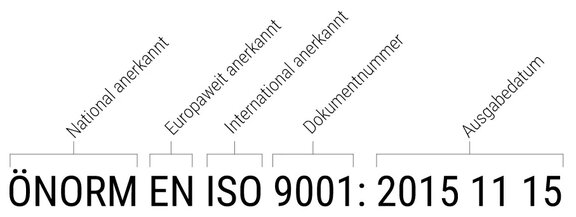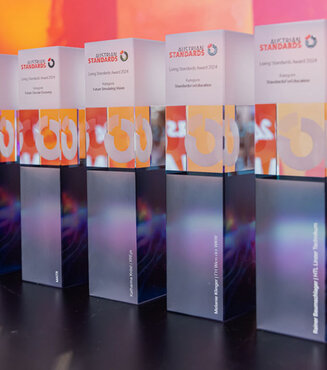
Understanding standards
Standards create practical, sustainable solutions for economic and societal challenges.
What are standards?
Standards:
- Are recommendations developed by specialists
- Represent quality, ensure safety and create trust
- Open up new, international markets to companies
- Act as a driver for innovation
- Generally are not legally binding
Standards act in the background and make our lives easier, safer and better.
This is evident in many areas, for example:
- Accessibility for an inclusive society
- The greening of buildings for climate protection, the energy transition and cooler cities
- AI to ensure the collaboration between people and machines is safer
They are key levers for economic success, as they enable companies:
- To signal quality to impress customers and suppliers
- To meet requirements to open up new target markets more quickly
- To optimise planning and production processes to increase the export share
Standards ensure marketable research results and drive innovations forward.
Examples of ongoing research projects:
- European Connected Factory Platform for Agile Manufacturing (EFPF)
Goal: Develop a networked smart factory ecosystem - Reincarnate
Goal: Reduce the construction industry's carbon footprint - SEALIVE
Goal: Reduce waste and pollution on land and in oceans
Standards reduce trade barriers and enable a properly functioning single market.
Examples of EU standardisation which make the markets more resilient:
- Green Deal
- Clear definitions and specific measured values
- Reduction of carbon emissions, environmentally friendly product design
- Circular economy and waste
- Digital transformation
- Artificial intelligence, 5G and IoT
- Data sovereignty and technology ethics
- Cybersecurity

of standards originate from Austria (ÖNORM standards)
different standards are included in Austrian Standards' portfolio
countries are part of Austrian Standards' partner network
Basic terms
The standard's name can be used to work out the origin or scope of validity and the date of publication of a standard.

An ÖNORM is an Austrian standard which is published by Austrian Standards International as the legally recognised Austrian standards body.
The document was developed as part of the national standardisation process.
An ONR (ON rule) is a guideline which does not have to meet all requirements of a traditional standard in its development process. "Workshop Agreements" (CEN, ISO) and "Publicly Available Specifications" (ISO) are equivalents at the European and international level.
An ONR is the right choice if the status of a new or rapidly evolving development is to be documented.
A European standard (EN) has been developed as part of the European standardisation process and is published by the European standardisation organisations CEN/CENELEC.
The document is given the "ÖNORM" supplement if it is included in the Austrian portfolio.
An international standard (ISO) has been developed as part of the international standardisation process and is published by the international standardisation organisation ISO.
The document is given the "ÖNORM" supplement if it is included in the Austrian portfolio.
The "Vienna Agreement" laid the cornerstone for the cooperation of the International Organization for Standardization (ISO) and the European Committee for Standardization (CEN) in June 1991. The agreement was signed in Vienna.
The cooperation is to ensure that European and international standards do not contradict one another and are broadly in agreement, in keeping with the motto: "One standard, one test – accepted everywhere". More than 90 percent of standardisation now generally takes place at the European and international level.
Factory standards are developed by companies for their own use. They are a summary of requirements which are relevant for a production process or a specific process in an organisation. In addition to internal guidelines, they may also include parts of one of more standards.
Living Standards Award
The winners of the Living Standards Award demonstrate how standards are used to:
- Shape economic success
- Drive forward innovations
- Make ideas exportable




